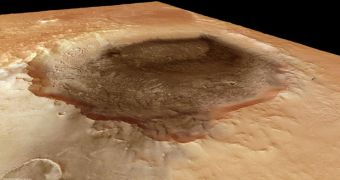Using its High Resolution Stereo Camera (HRSC) instrument, the European Space Agency's (ESA) Mars Express orbiter collected this amazing image of a Martian crater, back in 2005. Since then, experts have been analyzing it on all sides, in hopes of extracting new information about the intricate puzzle that is the Red Planet's weather system. Planetary scientists believe that the photo shows wind blowing inside a famous crater, and removing black sand from within, visible in the lower left side of the photo, Space reports.
The area containing this particular crater, called Meridiani Planum, is of special importance for the American space agency, and its Jet Propulsion Laboratory (JPL), because it represents the landing site of Opportunity, one of the two rovers of the MER program. Though the craft carrying the explorations robot missed its landing site by a considerable margin, scientists were ecstatic at the fact that Opportunity had landed inside a 31-mile-wide (50-kilometer-wide) crater. This opened up new directions of research for the rover, which is currently in its seventh year of roaming the surface of the Red Planet.
While the machine is gathering data about the geological processes that led to Mars looking the way it does today, orbiters above are trying to make sense of how winds blow on the planet. Their influence on the overall appearance of the general landscape is also a prime topic of research among scientists involved with analyzing the data flow. According to Brown University professor of geological sciences Michael Wyatt, this particular image gives researchers the possibility to establish the direction and speed at which the Martian wind was blowing while removing the black sand from the crater.
“If you know the direction of wind you can begin to understand weather dynamics. The wind on Mars is one of the most active processes for modifying the surface, and tells you a lot about the dynamics of the atmosphere,” the expert, who was also involved in the team managing the Mars rovers, said. “People have studied these types of things for decades, and there are hundreds and hundreds of craters on Mars where people have studied wind streaks. But these are some of the most beautiful and detailed pictures I have ever seen of it,” he added. Studying this particular crater, and the sand that comes out of it, is very important because the area has numerous similarities to regions of Earth that were shaped by liquid water.

 14 DAY TRIAL //
14 DAY TRIAL //